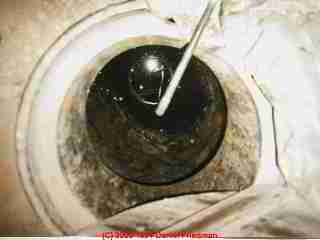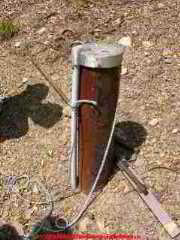 Drinking Water Wells, Well Types
Drinking Water Wells, Well Types
Well Construction, Diagnosis, Location & Repair
- POST a QUESTION or COMMENT about the differences among types of water wells
Guide to all types of water wells: well construction, troubleshooting, & repairs.
This article series describes how to identify types of wells and water pumps, and how to diagnose & fix water well problems or water pressure or water quantity problems.
We describe various types of drinking water sources like wells, cisterns, dug wells, drilled wells, artesian wells and well and water pump equipment. We provide advice about what to do when things go wrong.
InspectAPedia tolerates no conflicts of interest. We have no relationship with advertisers, products, or services discussed at this website.
- Daniel Friedman, Publisher/Editor/Author - See WHO ARE WE?
Private Wells & Water Sources - Home Page
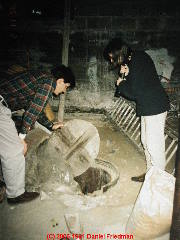 This article series describes the different types of sources use for drinking water: wells, cisterns, springs, different well types & different locations for water wells. Here is a comprehensive list of common drinking water sources & well types, and how to find the well, or how to fix well problems.
This article series describes the different types of sources use for drinking water: wells, cisterns, springs, different well types & different locations for water wells. Here is a comprehensive list of common drinking water sources & well types, and how to find the well, or how to fix well problems.
Index to Types of Water Wells
- ARTESIAN WELLS, WELL SPOOLS
- BASEMENT WELLS
- CISTERNS, WATER STORAGE
- DRILLED WELLS, STEEL CASINGS
- DRIVEN POINT WELLS
- DUG WELLS, by HAND
- JETTED WELLS
- SPRINGS as WATER SUPPLY
- WASH WELLS
- WELL LOCATION, HOW TO FIND the well
Use the page top or bottom search box, or see major water well topics are in the
water well ARTICLE INDEX or at the end of this page
Basement Wells
Before we discuss modern drilled or driven point wells and hand dug wells found outdoors, let's get this odd case out of the way first.
In some older homes you may find that the water well is a drilled or hand dug well located in the building basement or crawl space.
Wells located in the basement or crawl space of a building are sometimes found, usually at older, pre-1940 buildings. On occasion it appears that the well was originally outside the building but the building was expanded over it.
Early American construction sometimes located a well (or cistern) in a basement so that a mechanical hand pump could be located indoors (perhaps in a kitchen).
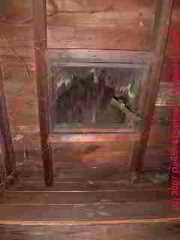 This
pair of photographs show my clients discovering that the plastic in the center
of the basement floor covered a flimsy wood cover which covered a hand-dug
stone lined well in the home's basement.
This
pair of photographs show my clients discovering that the plastic in the center
of the basement floor covered a flimsy wood cover which covered a hand-dug
stone lined well in the home's basement.
Some concerns for basement wells include the problem that if the building needs to be treated for termites there are extra costs because the well is certainly located too-close to the building.
Also if the building has a problem with basement water entry, depending on the type of well in the basement, there may be a risk of well contamination.
For a modern drilled well which has been "built over" during a building expansion, it becomes impossible to pull out and replace the well piping, foot valve, or submersible pump unless someone has cut a trapdoor into the ceiling/floor above.
Well problem diagnosis continues with the articles listed below.
WATER PRESSURE LOSS DIAGNOSIS & REPAIR starts
at WATER PRESSURE LOSS DIAGNOSIS & REPAIR
LIFE EXPECTANCY of WATER PUMPS - Well Pumps: how long should a water pump last? What affects pump life?
...
Reader Comments, Questions & Answers About The Article Above
Below you will find questions and answers previously posted on this page at its page bottom reader comment box.
Reader Q&A - also see RECOMMENDED ARTICLES & FAQs
Reader Question: identify well casing types
I was in the process of buying this home when we discovered this pipe hiding on the property. Do you know what this is? Is it some kind of underground oil storage tank? Thanks - F.L. 11/3/2012
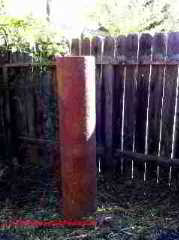 ...
... 
Reply: easy way to measure the depth of a drilled well and the depth to the top of its water
From looking at the fencing behind the vertical steel device in your pictures I infer that the diameter is around 6-8 inches - which would make this more likely a steel well casing, not an oil storage tank.
What was mysterious or maybe misleading was that apparent oil-stain like discoloration around the steel pipe elbow and close nipple connected near the top of the casing.
Here are some further investigation steps you can take to convince us we know what this is:
- look at and into the top of the casing for piping, wires, visible water
- drop a string or weight, perhaps with a rag attached, down to the bottom of the casing, measure the depth, and pull it back out. If oil were contained in this system you'd see it and smell it on the rag when you pull it back out. (Water hangs out at the bottom of an oil container so the rag would pass through any oil first)
- look inside the building for signs of old well piping at the basement or crawl space walls
- see our article on how to spot abandoned oil tanks -
at OIL TANK, BURIED, FINDING
On 2018-07-21 by Anonymous
Clised old well back up with water
On 2018-07-21 by Peggy
Well backs up water
On 2018-07-17 by (mod) - drilling three Wells is already an indication that there's a problem with water supply
In my opinion drilling three Wells is already an indication that there's a problem with water supply at a site.
The questions that you raised are perfectly reasonable but can easily be addressed by inspecting the well casings including by using a camera system. That might be a good place to start.
On 2018-07-17 by dennis
My son has had three wells dug for his house all three are producing a sedimentary brownish water .
He is trying to get someone to solve problem . My self i think either the well pump is to deep or the same person that did the wells , messed up the casings causing sediment to leak into water or a combination of all...
On 2018-01-27 by (mod) - signs of broken well pipe
Jo Ann
I suspect that the line to the mobile home is broken and leaks water like mad, perhaps underground.
On 2018-01-25 by Jo ann Karch
Have a well and cistern there are 3 lines ,the house the barn and a moble home.
We had the line to the moble home closed be cause the line was frozen. ,
We turned it back on after weather warmed up. Not only does the moble not have water, but as long as that valve is on the house has no water. . We turned it back off and the house again has water . Makes no sense to us !!
On 2017-05-05 by (mod) -
Kathy we give detailed advice about the questions you ask starting in these 3 articles, all found by using the InspectApedia search box just above to search for those phrases
WATER SUPPLY TURN-ON De-winterize a water system
WELL CHLORINATION & DISINFECTION - how to disinfect or shock a well
UV ULTRAVIOLET LIGHT WATER TREATMENT - water disinfection using UV light
Watch out: Beware that UV disinfection, to be reliable, may need sediment filtration, and also beware that other contaminants besides bacteria may be present. The article above discusses the limitations of the UV approach.
On 2017-05-05 by Kathy Dietrich
House sitting empty x 2yr with known "bad septic system". Septic in back of home, well in front yard with yard sloping towards well.
Well is 4" pipe, well testing POS for e-coli. Correct way to un winterize/chlorinate well & where to obtain samples from after chlorinating? Thoughts on UV system..will have 15 month old in home phone
815-427-8674/ kdietrich3@gmail.com... IM IN PANIC MODE..THANK YOU
On 2016-10-03 by Anonymous
Small valve next to pressure switch leaking what could be the issue
(Apr 4, 2014) Jamie said:
That is a common method used for containing old drilled wells. The large pipe has been pushed over the existing drilled well pipe. If i had to guess the water has a high salt content (drilled too low) and the pipe had rotted. I know this because I have a property with the same problem.
On 2012-10-04 by ken
The top 3' of my basement well is constructed of red brick without mortar in between. Some of the brick have fallen in the well so I have to the last 3' of the well. Any ideas on how to do this?
On 2012-09-28 by (mod) -
Lynn you need an onsite plumber to inspect to see whatmyou have. If there is a wel
We ought to be able to see a cover or casing.
On 2012-09-28 by (mod) -
Chuck, oil floats atop water - perhaps you can pumpmit out;
I would ask for help from a well driller, pump out the casing and well entirely once, sanitze the well, and have the water tested again. Don't run contaminated well water through the rest of the plumbing system.
On 2012-09-26 by J
well motor pump sprung leak
On 2012-09-22 by chuck
old well pump rotted out on bottom leaked oil into well.
how do I get rid of oil in water in house? Or, do I just Need to let It pass?
On 2012-09-21 by Lynn Tranah
I have what I think is a well in my cellar. The building is an old chapel and was built in 1888.
Since I have owned the property 2 1/2 years it has not been a problem. The water is clear and we have dug through the concrete a circular hole about a foot deep. We are pumping it out but it worries me. How can we establish it is a well and will it cost a fortune to control it if it is?
On 2012-07-09 by Alicia
The water comes out dirty
On 2011-09-06 by (mod) -
John I think I'd either take a grassy water sample to a test lab or have someone examine the fragments directly by high power microscopy so that we know what you've got in the well water. It could be that the well casing is cracked and roots are invading the well? I'd offer to take a look (pro bono) but am working out of the U.S.
On 2011-09-05 by John Gould
I have small dark brown to black pieces of what looks like roots or grass in the well water.
It plugs up the screen in my washing machine line about twice a week and has to be cleaned out. I can not use my whole house filter on the well tank as it plugs up the filter. The water is excellent and the health dept and my county agent do not know what it is
On 2011-08-21 by S. Gamble
standing water on ground around well. does not appear to be stagnant.
On 2011-07-22 by (mod) -
Insulating the water pressure tank exterior:
Good question. I have see folks try this with fiberglass insulation, only to create a mess and a little mold reservoir. There are, however, thermal blankets intended for water tank insulation, often sold as an effort at freeze protection.
WATCH OUT for these serious safety hazards when insulating a water tank:
1. unlike advice I've seen on eHow and similar websites, DO NOT add insulation to a hot water tank without checking with the manufacturer - you may void the tank warranty, and worse, if you obstruct the pressure relief valve in any way the result can be very dangerous
2. If insulating a water pressure tank (as we are discussing here) you should select a material that itself will not absorb water or moisture, such as a plastic or foil-covered insulating material. And do not block water tank controls, valves, gauges, nor the pressure relief valve.
On 2011-07-21 by conradyanis@hotmail.com
Good article. My well water is very cold and I experience much condensate on the well tank which drips onto the wood floor below it. Is there a product with which I can insulate the tanks exterior?
Question: spring fed cistern, how to handle overflow
(Apr 5, 2014) Chris Shields said:
I have a spring fed water system, and a concrete cistern in the upper yard of my country home. A problem I have periodically is cistern drainage. The current system I have rigged up,(don't laugh) is a garden hose that routes the overflow to a nearby (100 ft.)stream. It works fine until the drainage and/or usage exceeds the inflow, causing air to get in to the drainage hose.
Then the water will not restart into the drain and the cistern will overflow until I break the hose and get it going again. Question is, do I need more downslope in the drainage line, or is there some sort of airlock thing happening that can be remedied by air holes in the drainage hose.
Reply: how to increase water pick up from a cistern
Chris, this is an interesting problem since we don't want to put the hose pick-up end deeper into the cistern - that would risk siphoning out water that you want to use when cistern levels are higher.
I think a better solution would be to modify the cistern to make a spillway in the form of either a hole drilled through the cistern wall a few inches from the top. Seal the garden hose to the hole on the cistern face and when water level reaches that height, and provided the hose slopes down continuously from that point, you'll drain by gravity with no problem.
(Apr 5, 2014) Chris Shields said:
Thanks so much for the prompt reply. I would point out that I am using a proper drain hole that comes out of the side of the cistern near the top. The original drain line was compromised by a backhoe working nearby on another project, so my gardenhose rig is a temporary solution.
It is running fine as we speak, however as soon as the cistern level reaches the drain hole and air gets into the line, the flow will not resume on it's own until I pull the hose apart about 15 feet below, then it flows normally until the above situation occurs.
Reason this happens is that the line from the spring begins to slow gradually from silt, which I ultimately have to blow back with air pressure to clear the line, but that's another story. Sounds to me that the hose has a few little "ups" in it that are preventing gravity flow and I need to be sure my route is continuously downslope. I welcome any further comments, and thanks again.
Reply:
I think I need to see some photos or a sketch (use the CONTACT link at page bottom if you like).
I don't understand "as soon as the cistern level reaches the drain hole and air gets into the line, the flow will not resume on it's own until I pull the hose apart about 15 feet below,"
unless you mean that once cistern level has fallen BELOW the drain hole air enters the hose line and then when cistern level returns it won't drain.
About clogging, it's no surprise on a line that does not slope continuously downwards; not just air but debris will collect at these interrupt points.
You could try a larger diameter drain, a spillway (which probably is no good for your situation), maybe a clever use of check valve?
I've successfully drained various things using a garden hose that extended far enough that it could siphon over the little ups and downs, but any of these will have the problem you describe once air can get into the line - you have to start the process over again once siphonage is interrupted.
It'd be worth making sure the line slopes continuously downwards without high spots.
I'll research this further but without adding power and pumps or a local spillway, air in an up-and-down drain hose seems to me to be an innate design problem; just like those perpetual motion machines, expecting free energy doesn't work well.
(Apr 7, 2014) Chris Shields said:
Your comments [above] in paragraphs 3 and 6 are exactly the condition I have. Currently the cistern drains fine until the level drops below the drain hole, interupting the siphon., until I pull the line apart about 15 feet below the cistern, then the water flow begins on its own.
How about if I drill some little holes in the garden hose below that point to relieve what seems to be an air lock? Failing that, I will dig a trench to eliminate the few little up bumps that are in the line. Thanks, again, any further thoughts welcome
Reply:
Chris
You can drill holes in the top surface of the hose if you want to vent air out - and of course expect water to exit and possibly dirt to enter at that point. You could drill air vents, place geotextile over the vents, hope the system works, and it may, but
Ultimately you probably want
- a larger diameter overflow drain - unless the inflow to your cistern is very slow
- steps to be sure that the hose or drain pipe always flows downwards at 1/8" to 1/4" per foot of run.
Question: muddy artesian well
(Sept 20, 2014) Diane said:
Could an artesian well cause water and mud to come up through the thin layer of concrete covering our crawl space floor? There seem to be little peas of mud appearing on the concrete. It also seems awfully damp down there. What shall I do?
Reply:
Possibly yes if the well spool in the artesian well is leaking and the well is under the floor (which would be odd but not impossible)
Or if there is a well piping leak under the floor. Any other water source could have similar effect.
Question: worry about possible collapse of underground cistern
(Sept 28, 2014) Caitilin said:
Hello! I have a home that will be 100 yrs old in a couple of years. Between the detached garage and the back of the house, there is an underground cistern made of brick. I believe the cistern is 12 ft wide and 12ft long and approx 10ft deep. We have never used it.
The hole at the top has always been covered by a cement moveable cap. There is a planter on top of it. We have lived here for approximately 15 years.
I am concerned about the possibility of it collapsing one day. I do not have a very big budget, but I would like to know what my options are as far as filling it in. Someone suggested filling it in with pea gravel, which would still allow water in there, but would keep it from becoming a collapsed 12 x 12 hole that could also effect the garage and/or home structure?.
Reply:
At SEPTIC TANK ABANDONMENT GUIDE you will find suggestions for abandoning any large underground tank, cistern, etc. Generally, provided it is safe to enter the cistern, we'd break a few holes in its bottom and then see that the cistern is filled with rubble (stone) and sand.
Question: odor in water from concrete cistern in Ensenada Mexico
(Oct 28, 2014) Al said:
We have rented a home in a little south of Ensenada Mexico. We have a 2000 gallon concrete water holding tank that is filled by truck, not potable, use for daily needs. The water is very hard and has slight odor. What is safest solution to kill bacteria and soften water.
Reply:
Al, A chlorine injection system may be effective.
At WELL CHLORINATION SHOCKING PROCEDURE you'll find information about both the bleach concentration and the contact time necessary to effectively disinfect water.
For solving hard water problems
see WATER SOFTENERS & CONDITIONERS - topic home, and also
see WATER HARDNESS: HOW TO MEASURE
Question:
(Dec 31, 2014) Laura said:
I will be moving into a property that uses spring fed water that is then stored in tanks. I'm interested in knowing what type of storage tank is best for drinking water? Have plastic tanks been tested to ensure that plastic doesn't leach into the water that is stored over long periods of time?
What about steel tanks? and finally, if water testing shows that coliform bacteria is contaminating the water supply, what purification method is best? We've heard that there are electric ozonators as well as addition of chlorine? What are the advantages and disadvantages of each?
Reply: difficult to deliver potable water from a spring source
Laura it is difficult to deliver potable water from a spring source. After having your water tested you'll know what treatment is needed. In the More Reading limos above see WATER TREATMENT EQUIPMENT CHOICES where we describe the various approaches including the ones you ask about.
When you've read Thad do let me know if any of that nformationis unclear. If you like, a search of InspectAPedia for Spring as water source. Will direct you to articles about that water source.
Question: dug well sanitation: a snake got into my well
Lois said:
I have a dug well which is my source for my house. Once before, I had a snake get into it and contaminated it. Went through the Shock Chlorination after pumping out the well. Just had water tested again and it was positive for coliform and e-coli. I use bottle water for drinking.
I would like to contact a professional that can tell me what needs to be done to rectify the situation, once and for all.
The well is under my decking set in concrete surroundings but the well itself is stone. I've asked before if a cap shouldn't be on top of the opening and was told, the way it is, is how it should be.
Of course, I understand critters and whatever can easily get into the well. I need accurate and sound advise. Thank you.
Reply:
Lois it is difficult if not impossible to guarantee that water from a dug well remains sanitary and potable as it is so easy for surface water to enter the well. For this reason it makes sense to test the water for common contaminants found in your area, including but not limited to bacteria, and then to install a water treatment system that will address these.
A one-time well shock, as you agree, won't permanently fix a dug well.
Indeed you do want a critter-resistant cover as well as one that is safe against kids or anyone falling into the well, but depending on how the well is constructed even a solid thick reinforced concrete cover may not keep animals from entering the well through its sides. So periodic inspection and testing remain in order.
...
Continue reading at ARTESIAN WELLS, Well Spools or select a topic from the closely-related articles below, or see the complete ARTICLE INDEX.
Or see these
Recommended Articles
- DEPTH of a WELL, HOW TO MEASURE
- WATER FLOW RATE CALCULATE or MEASURE - how much water is delivered at a plumbing fixture
- WATER PRESSURE MEASUREMENT - water pressure in the system, dynamic & static
- WATER PUMP CAPACITIES TYPES RATES GPM
- WATER QUANTITY IMPROVEMENT
- WELLS CISTERNS & SPRINGS - home
- ARTESIAN WELL FREEZE PROTECTION
- ARTESIAN WELLS, WELL SPOOLS
- BASEMENT WELLS
- CISTERNS, WATER STORAGE
- DRILLED WELLS, STEEL CASINGS
- DRIVEN POINT WELLS
- DUG WELLS, by HAND
- WELL WATER CONTAMINATION: CAUSES, CURES - home
- WELL FLOW RATE
- JETTED WELLS
- OLD WELL - RETURN TO SERVICE
- SPRINGS as WATER SUPPLY
- WASH WELLS
- WELL FLOW RATE - how much water can the well deliver
- WELL FLOW TEST for WATER QUANTITY - how to test the well
- WELL LIFE EXPECTANCY - how long will the well last?
- WELL YIELD IMPROVEMENT - get more water
- WELL YIELD, SAFE LIMITS - safe total well yield, causes of flow rate change
- WELL LOCATION, HOW TO FIND
- WELL WATER PRESSURE DIAGNOSIS
Suggested citation for this web page
WELLS CISTERNS & SPRINGS at InspectApedia.com - online encyclopedia of building & environmental inspection, testing, diagnosis, repair, & problem prevention advice.
Or see this
INDEX to RELATED ARTICLES: ARTICLE INDEX to WATER SUPPLY, PUMPS TANKS WELLS & SPRINGS
Or use the SEARCH BOX found below to Ask a Question or Search InspectApedia
Ask a Question or Search InspectApedia
Try the search box just below, or if you prefer, post a question or comment in the Comments box below and we will respond promptly.
Search the InspectApedia website
Note: appearance of your Comment below may be delayed: if your comment contains an image, photograph, web link, or text that looks to the software as if it might be a web link, your posting will appear after it has been approved by a moderator. Apologies for the delay.
Only one image can be added per comment but you can post as many comments, and therefore images, as you like.
You will not receive a notification when a response to your question has been posted.
Please bookmark this page to make it easy for you to check back for our response.
IF above you see "Comment Form is loading comments..." then COMMENT BOX - countable.ca / bawkbox.com IS NOT WORKING.
In any case you are welcome to send an email directly to us at InspectApedia.com at editor@inspectApedia.com
We'll reply to you directly. Please help us help you by noting, in your email, the URL of the InspectApedia page where you wanted to comment.
Citations & References
In addition to any citations in the article above, a full list is available on request.
- In addition to citations & references found in this article, see the research citations given at the end of the related articles found at our suggested
CONTINUE READING or RECOMMENDED ARTICLES.
- Carson, Dunlop & Associates Ltd., 120 Carlton Street Suite 407, Toronto ON M5A 4K2. Tel: (416) 964-9415 1-800-268-7070 Email: info@carsondunlop.com. Alan Carson is a past president of ASHI, the American Society of Home Inspectors.
Thanks to Alan Carson and Bob Dunlop, for permission for InspectAPedia to use text excerpts from The HOME REFERENCE BOOK - the Encyclopedia of Homes and to use illustrations from The ILLUSTRATED HOME .
Carson Dunlop Associates provides extensive home inspection education and report writing material. In gratitude we provide links to tsome Carson Dunlop Associates products and services.


